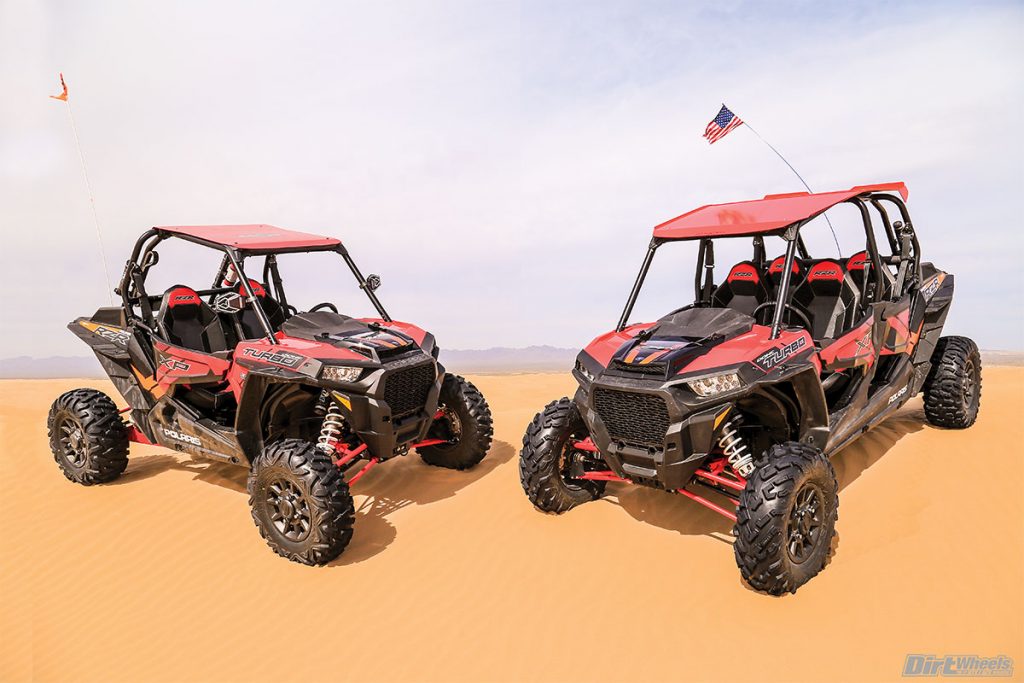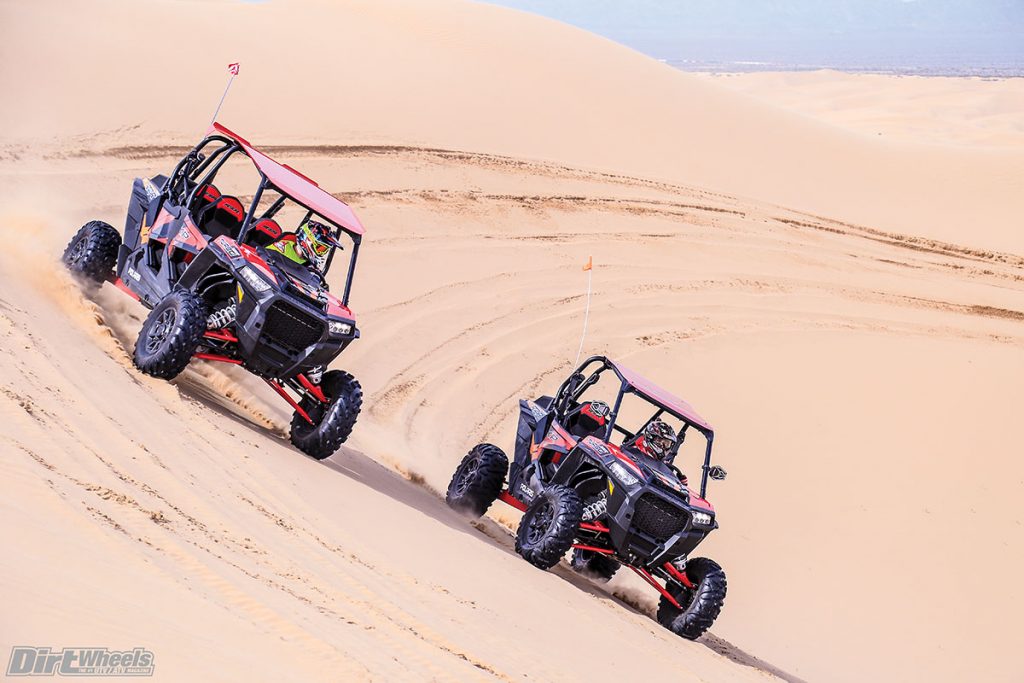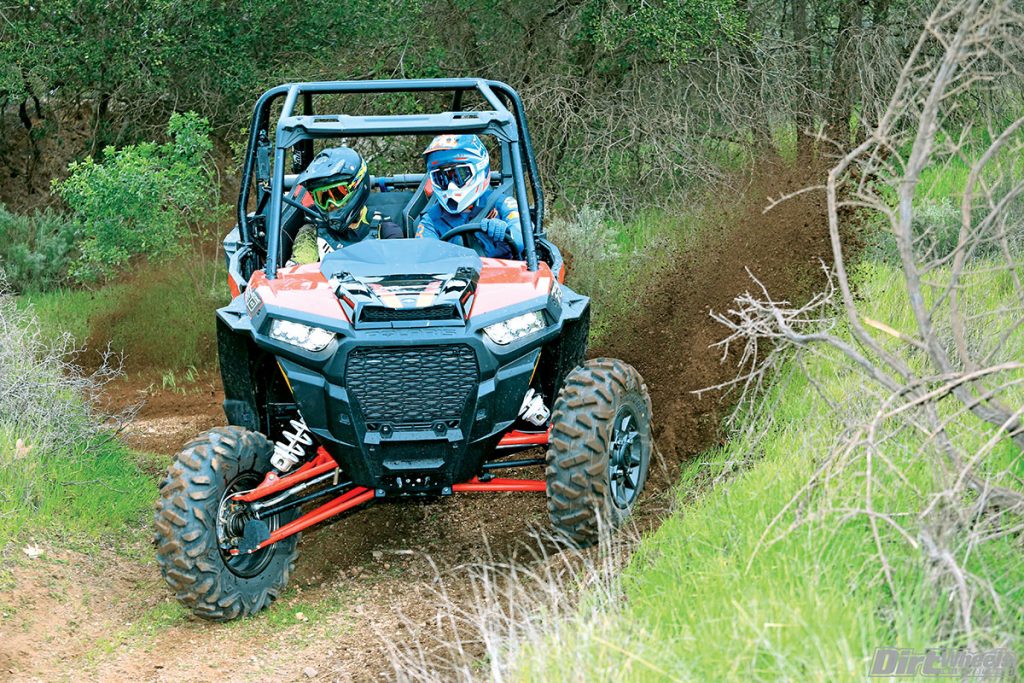SHOOTOUT: TWO SEATER VS. FOUR SEATER UTV
Which is better for the money? By the staff of Dirt Wheels.

There are as many reasons that buyers use to select a new UTV as there are grains of sand in a face full of dune roost. Sure, they differ from person to person and from family to family. Some, happily, are based in fact and logic and, frankly, salesmen hate those people. They would much rather deal with an impulse buyer that responds to a pitch like, “You would look great in this machine!” More so than any other OHV, a UTV may require input from other family members. For some, the utility aspect may be a genuine need, or at least a selling point to sway your significant other or the tax guy. More and more each year, one major decision that you should consider is whether you should purchase a two-seat model or go for a four-seater (or five- or six-seater in some cases). There are some very good reasons to both sides of the question.

CHOICES
Machines with more than two seats come in a couple of different flavors. The first type are those that sacrifice cargo area for added seating. The primary examples here are the Honda Pioneer line and the Kawasaki Teryx. In both cases, the overall size of the machine is almost identical in the two- or four-seater (three- and five-seater for the Pioneer 1000-5). The Teryx4 has permanently limited cargo area, while the Honda’s bed floor cleverly converts into two rear seats. It has a full-size dump bed when the seats are stowed.
The second type are machines that have extended-wheelbase frames with a permanent second row of seating. In most cases, the cargo area remains unchanged between a two-seater and the crew cab model. For both types of crew-type UTVs, there is a weight penalty, usually slightly higher cost and, in some cases, reduced towing or bed-load rating to consider as well. A few have reduced ground clearance, but the difference is usually minimal.

MONEY
We live in the real world where money definitely matters. In every case a machine with more than two seats costs more than a standard model. The five-seat Honda Pioneer is $2200 more than the standard model, or a 13.6-percent price increase. The Kawasaki Teryx4 has a $2900 price difference for the crew model, and that is an 18.4-percent jump. That price difference is understandable considering that the Honda seats, while comfortable enough, are basically pads mounted to the framework under the bed floor, while the Kawasaki has four full bucket seats.

Without the special pricing that came with the Arctic Cat/Textron merger, the Wildcat 4 is a deal at $2000 more than a Wildcat, or just 10 percent more. The Polaris Turbo 4 and the Can-Am X3 Max are close at a difference of $4500 and $4400. But with the higher price of the high-performance models, the difference is roughly 16-percent more for the four-seat versions. Polaris’ popular General is approximately the same. The four-door is $3200, or 15-percent more.
Price is one thing, but price and value are not necessarily absolute. If you have three or four people in the family, the price difference is a bargain compared to buying two two-seaters. With two machines, you are looking at a 100-percent price jump even before you take into account upkeep and tires on a second machine. (Not that we discourage folks from owning more than one machine—live the dream).

PERFORMANCE
For some riders, the local terrain is just not friendly to extended wheelbase machines, but for this performance section, we will assume that the long cars do fit your trails; they for sure do here in the west. In terms of engine performance, none of the available machines we know of have a more powerful engine to accompany the added passenger room, but all weigh a bit more. Kawasaki managed the weight increase the best of our sample machines with a mere 32-pound weight penalty for the added seating.
The Polaris XP line does a pretty good job as well, gaining only 196 pounds compared to 231 for the Wildcat and 243 for the Can-Am X3. The Pioneer’s added cage, bed underpinnings and other changes add 254 pounds, and the General with the addition of a longer frame, two bucket seats and two full, large doors with inner door panels for the Polaris General 4 bump the weight 366 pounds. We ran identical 2017 Polaris Turbos up the famed Oldsmobile hill at the Glamis Dunes. The two-seater peaked at 46 mph on the climb, while the heavier Turbo 4 reached 40 mph.
For all of these machines, the acceleration difference is the same as having an extra passenger in the machine. Not bad, but certainly something you notice.

HANDLING
If you fill every seat with a full-sized adult, you will feel a difference in the handling. There is a reason, though, that many top desert UTV racers begin with a long-wheelbase four-seat chassis and convert it to two or even a single seat for racing. The longer wheelbase creates a car that has very calm-handling character that stays more stable through the rough. When trails get rough and ledge-filled, a long car can have ground-clearance issues, but more often it will stretch between high spots. One rock waterfall that gave both the Polaris and the Can-Am Turbos fits was an easy cruise for the four-seater. Rocks that high-centered the two-seaters also stopped the four-seaters, but they reached the sticking point more easily.

Any time we are dealing with extreme climbs or drops, we feel more in control in a long-wheelbase car. The staff speedsters who originally moaned when they found that our 2017 Polaris XP Turbo was going to be a four-seater have changed their tunes after hitting our normal test loops with the longer machines.

SUSPENSION
Again, there is little difference in suspension feel when the machine gets the added seats in the same wheelbase as a two-seater. As a general rule, the longer-wheelbase cars get through the rough better. Single bumps that would kick up the rear of a shorter car are taken with a more level attitude. Naturally, there are other factors like suspension travel and the actual suspension geometry, but longer machines feel like they have better suspension than a shorter machine with the same suspension.
The massively long Can-Am X3 Max feels like the rear passengers could take notes or sip espresso while hammering through the rough. We’ve had the same experience with shorter-travel machines like the Textron Off-Road Stampede and the Polaris General.

UTILITY
Whether you are hunting, camping or just working with your UTV, some utility is a necessity. Depending on the use you intend, you should look carefully at all the numbers before making a choice. For example, the two Teryx models have the same load rating that combines passengers, cargo and added accessory weight. But, where the Teryx can carry 600 pounds in the bed, the Teryx4’s smaller bed is rated for 249 pounds. Also, many of the sport UTVs have no towing capacity at all. The Polaris General line is the only one we have noticed that has greater load capacity for the four-seater, with the bed capacity and towing being the same. If you aren’t using the back seats, you can safely carry cargo there that amounts to the weight of two adults.
EAST VS. WEST
As we touched briefly earlier, it doesn’t matter how well the long-wheelbase machines ride if they are stuck between trees. Long machines may have trouble with the steep approach angles of mud holes and stream banks. Any reduced ground clearance can be a factor as well. When we hear about owners shortening the trailing arms for the woods, the Can-Am Max may have issues. In the west, the longer cars work extremely well, hold value and are easy to resell.
This might be a good place to mention transport. If you are riding right from your own property, on your property or live in a state that allows some ability to drive between trail sections, then trailering your machine may not be an issue. But, if you must transport your machine for a minimum of an hour like we do, then it can be a big deal. Toy hauler ads in the west always make note of whether a four-seat machine will fit inside or not.
Some states limit the total length of vehicles. In California, it is 65 feet, so a 40-foot motorhome can tow only one long-wheelbase machine. Our trailer has a 30-foot deck, and it will carry two four-seaters but will fit three two-seaters.

COOL FACTOR
Some of the staff don’t understand this aspect of the buying equation. Those are the “just so it works” and “has good value, we are in” guys. But, we also have staff who belittle long cars as station wagons, minivans and school buses. You’ll have to figure out where you fall on this issue on your own.

THE VERDICT
Among the group of riders we associate with, there are families that would consider nothing but a four-seater, and at the opposite end of the spectrum are those who will own nothing but a two-seater. In one case the driver prefers the ride and performance of a sport four-seater but doesn’t want the responsibility for the safety of other passengers. Others in our group would choose a long-wheelbase four-seater but don’t want to get a longer trailer to tow it with.
On the West Coast, a four-seater can be a highly effective machine in terms of comfort and performance, even with just one person in it. On the East Coast there will be an equal number of areas that they make no sense at all, unless they are the Honda or Kawasaki short-wheelbase designs.
Of course, if you have a family of four, you are just looking at the photos here, because you know what you need.




Comments are closed, but trackbacks and pingbacks are open.